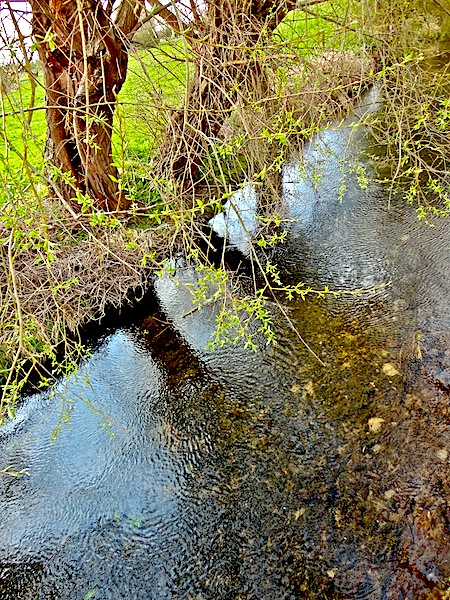There is a medieval water meadow near to our home, which is of international importance. It is one of the finest examples of a lowland hay meadow in Europe. It is protected as a Special Area of Conservation and a Site of Special Scientific Interest. The meadow supports 80% of Britain's population of the snake's-head fritillary, Fritillaria meleagris. Over 500,000 of these beautiful and nationally scarce flowers thrive in the meadow.
Marsh marigolds grow along it's borders where they meet with the fledgling River Thames on it's journey to London
River Thames
It is incredibly hard to photograph these little jewels unless you are prepared to lie prostrate in the grass. However, that is not my style!
-----------------------------------------------------------------------------------------------
Fritillaries in our garden - Crown Imperials
Fritillaria imperialis - Maxima Lutea
Fritillaria Imperialis - Rubra
Fritillaria meleagris - this shows why the flower is known as a snake's-head fritillary
I can photograph them better in the privacy of my garden!
They turn up in various shades of deep/pale pink, cream/white
Fritillaria persica
and the dear little fritillaria - uva-vulpis

and Mr. Frog from our pond
Fritillaria meleagris - this shows why the flower is known as a snake's-head fritillary
I can photograph them better in the privacy of my garden!
They turn up in various shades of deep/pale pink, cream/white
Fritillaria persica
and the dear little fritillaria - uva-vulpis

and Mr. Frog from our pond
















Snake's head Fritillary.. What a delightful little flower. They even look like little hanging lanterns. The place is magnificent. How incredible that the river Thames runs close by your home.
ReplyDeleteYour horticultural knowledge is amazing Rosemary. I learn so much reading your lovely posts. The beautiful yellow marigolds.. and the frog in your pond. Really nice post.
Thank you
val
The little snake's head fritillary flower is just a delight. I always look forward to its appearance in the garden. We seem to have conditions that they like and have many more each year.
DeleteMr frog is rather lovely, he has such a beautiful gold eyes.
Beautiful photographs, as always. I am continually intrigued by the designs that nature repeats — the purple snakehead with its almost checkered pattern reminds me of certain sea shells.
ReplyDeleteBefore the snake's head flower fully opens it does seem to resemble certain sea shells that you see around. The checkered pattern is, I think, a very interesting feature of the flower. I can still remember my surprise at its design when I saw my first one.
DeleteGorgeous, Rosemary. That brightened a grey day.
ReplyDeleteGood - pleased about that.
DeleteHow lovely, Rosemary. Your garden must be beginning to show all its loveliness. I wish I could wander around it with you as my guide! However, I'll settle for your wonderful words & photos. We look forward to more...
ReplyDeleteCarolyn
Dear Carolyn - if only you could come for a wander around the garden with me, that would be perfect. I tried to Skype you last night without success.
DeleteAll those beautiful flowers you have in your garden, love to see them.
ReplyDeleteThanks for sharing, Rosemary.
Mette
Dear Mette - thank you, these particular spring flowers, I think, are very beautiful too.
DeleteDear Rosemary, Oh my, how beautiful, the Fritillarias and your photographs. I am always so grateful to societies who have the foresight to protect such natural and stunning habitats.
ReplyDeleteox, Gina
Dear Gina - I love the genus Fritillaria, they are such dainty pretty flowers, and sadly they shall soon be on their way until next year. People are, fortunately, much more aware of protecting wild flowers and animals than they used to be, and that is a good thing♥
DeleteGreat photos! Isn't nature wonderful? With the tons of colours and patterns, there's always something to look at and admire. Great job capturing the beauty.
ReplyDeleteDear Marie - glad you enjoy seeing the photos. Yes, I agree, the colours and patterns in nature are a continual source of joy and beauty.
DeleteWonderful post Rosemary, I am extremely keen on Fritillaries! The imperialis is exciting but I think good old meleagris is my favourite. Hopefully get to visit one of the ancient meadows one of these years. Oh and hello Mr. Frog!
ReplyDeleteDear Bertie - same here, love the Fritillaries. If you go to the meadow, either Cricklade or Oxford they are just at their peak now, do try to see them.
DeleteI have never seen this flower. I so like the yellow ones in your garden. Interesting that the Thames looks like any other small river which is not the way that I remember it. Of course that was in. London. That is a very happy looking frog. I would be happy living in that garden too! Janey
ReplyDeleteSeeing the source of any river is always a really interesting and almost unbelievable experience, especially discovering that they start from a simple spring and gather pace as they travel.
Delete